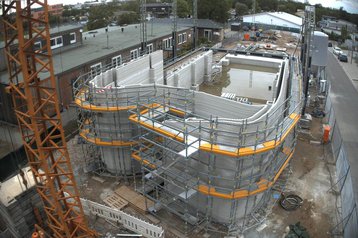Earlier this year, I went to Germany to see the world’s first and only 3D-printed data center.
The 500kW site holds a handful of titles: The world’s first 3D-printed data center, the first 3D-printed industrial building, and the largest 3D-printed building in Europe.
It might well be one of the most widely-covered data center builds in history; the project has drawn press from across the world to marvel at its unique design. The single-story building totals just under 600 sqm (6,600 sq ft); 54 meters long, 11 meters wide, and 9 meters high; unremarkable in terms of size. But instead of flat walls and right-angled corners, the building is a mass of curves, ridges, and layers.
It was only made possible by the ambition of two eccentric Germans; the owner of a local real estate firm and his friend who runs a local MSP and needed a new data center. They admitted the project cost double what was originally planned for the traditionally-built, right-angled data center that was previously due to be built there.
We at DCD love the novel, the eccentric, the odd, the unique. I loved the story, the aesthetics, and the fact it tried something new. It’s why we made it the cover of our magazine. But is it in any, shape, or form, actually practical for the industry?
3D printing proponents will tell you that you can build quickly and cheaply with less staff on-site compared to a stick-build or other construction techniques. They’ll tell you that while the materials are more expensive than traditional concrete, you’re ultimately using less of it, and material that can be recycled. There might be appeal and utility when it comes to residential dwellings, but 3D printing has its physical limits that impact its potential in the data center space.
The height of the facility will be limited by the height of the printing platform; some printing units sit on scaffolding, others have arms and lifting mechanisms, but all are limited by the reach of the extruder. Most 3D-printed buildings are single-story, and though there are some that are two-story, these are far less common.
Regulation and certification are also an issue. Most places in the world don’t have much in the way of building regulations for 3D-printed buildings, so will take a very cautious approach to such projects. Certification for 3D printing is also in its nascent stage, so projects will often have to over-engineer designs out of an abundance of caution from regulators.
The people behind the 3D-printed data center in Germany say they will use the technology again for future builds. But the idea of a 3D-printed hyperscale data center seems a long way off at this point. While there might, maybe, potentially, be some utility in 3D-printed Edge facilities of some description, I can’t help but think, why bother?
Most of the 3D-printed companies we spoke to said there's currently limited interest from the industrial sector, given the limitations around the size of scale of what's currently possible with the technology.
DCD asked a couple of Edge data center firms for this piece if they or their customers were interested in 3D printed facilities; and the answer, broadly, is no. They’ve not thought about it, and no one’s asked for it.
Aside from the site in Germany, the only other company known to have an interest in 3D printing sites decided to just reuse an existing building instead because it was more convenient.
But never fear. We already have data centers that can be deployed quickly, cheaply, with a skeleton workforce, and minimal planning restrictions. They’re called modules and containers.
Data center modules and containers are a well-established way to deploy capacity. They are a mature technology already provided by companies big and small across the world. You place an order, wait for it to be built, ship it in on a lorry, and crane it to your desired location. Job done.
Is 3D printing a solution looking for a problem when it comes to data centers? Almost certainly at this point. Could it become more useful in the future if the prices come down and planning restrictions are eased? Perhaps. But still, it seems more effort than necessary when the industry already has a solution that works.
The Edge firms DCD talked to said they like containers and modules because they are quick to build, modify, ship, and deploy. But they weren’t totally dismissive of the technology, and said it could be a part of the toolset in future if it is proven out a bit more.
Maybe there’s more going on behind the scenes than DCD has heard about. Maybe we’re on the cusp of a wave of 3D-printed data centers. Or maybe it will remain the preserve of eccentric developers and operators in the provinces.
-

News from the hydrogen frontline with EdgeCloudLink CEO Yuval Bachar
We speak to a CEO running a 1MW facility on fuel cells, with DC power distribution
-

The Wavehouse: 3D printing a data center
The story behind the world’s first 3D printed data center
-

3D printing: A revolution in construction?
An overview of 3D printing





